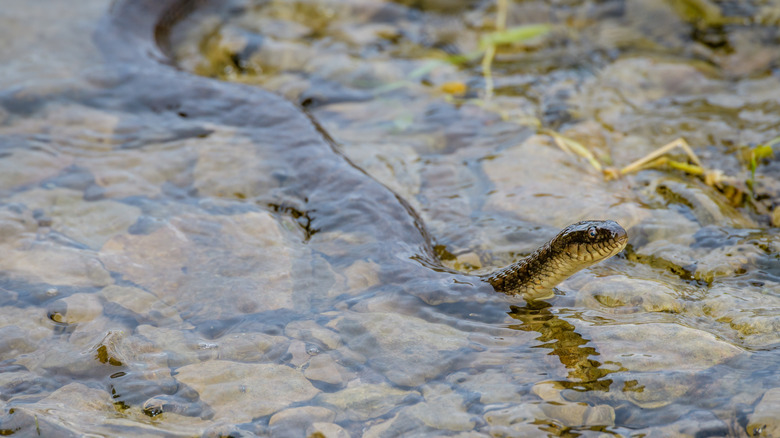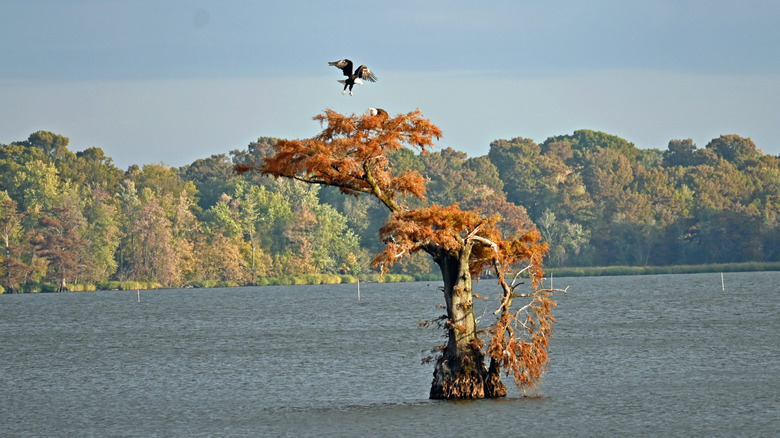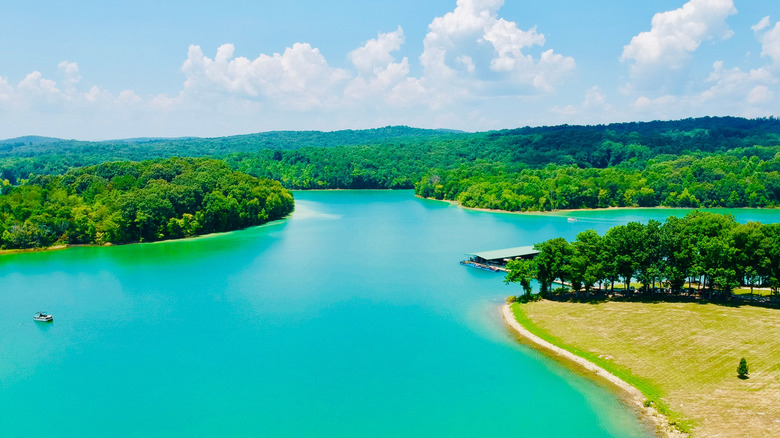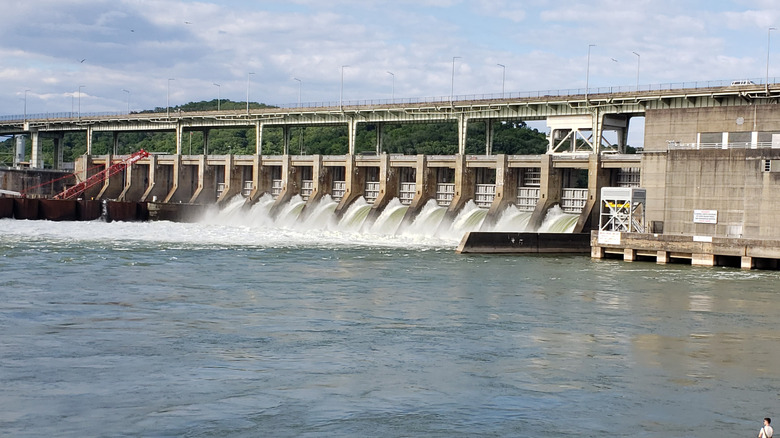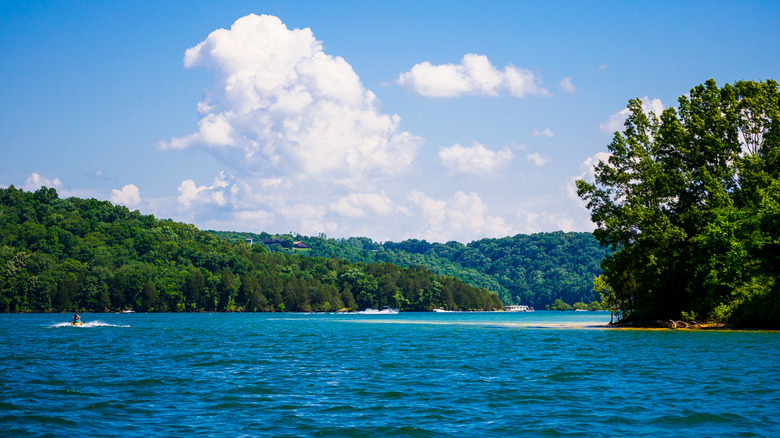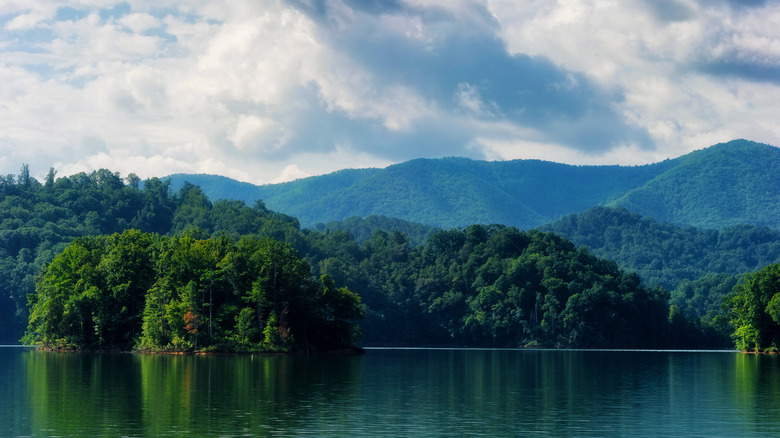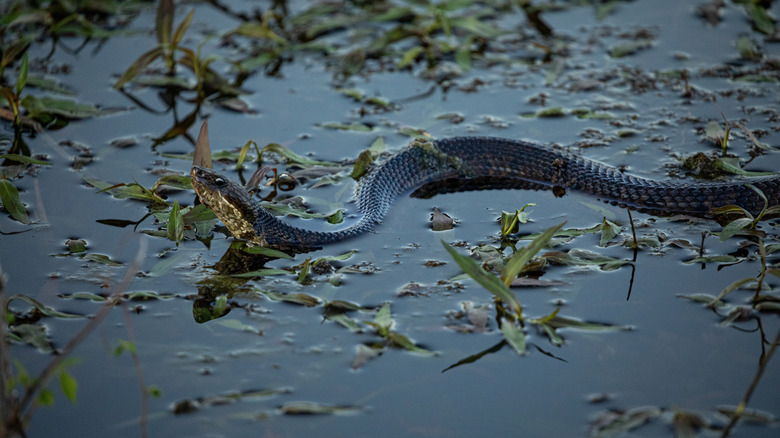Tennessee's Most Snake-Packed Lakes Aren't For The Faint Of Heart
Flanked by the foothills of the Smoky Mountains or in coves of pine forests, Tennessee's lakes are spectacular getaways for swimming or fishing for catfish. Catfish aren't the only creatures that live in these lakes, though. There are quite a few snake species native to Tennessee that live in water habitats, albeit only one of these is dangerously venomous: cottonmouths, also known as water moccasins, readily identified by their white-lined mouths. Still, even nonvenomous snakes can bite.
You're most likely to spot snakes in Tennessee during early spring or early summer, as these are the times when they come out of brumation for feeding and then enter breeding season. Typically, snakes won't initiate any form of aggression towards you unless they're disturbed, so the most surefire way to avoid getting bitten is to leave them alone. Still, if you're in the water, you might not see a snake and end up disturbing it unwittingly. There's a chance you could get bitten — most of the time, you can wash the wound and it will heal on its own, but bites from a venomous snake can be deadly, so you'll need to head to the hospital as soon as possible.
If you're particularly fearful of snakes, these lakes might be ones to avoid, but for many travelers, it's less about steering clear entirely and more about knowing what to expect and where to be cautious. Different lakes attract different types of snakes — cottonmouths, for example, are mostly found in the slower-moving, lower-elevation waters of Western Tennessee, while harmless northern watersnakes can be found basking on the rocky shores around lakes of the Smoky Mountains. These reptiles are part of the state's natural ecosystem, and with a healthy dose of awareness, you can safely share the water with them.
Reelfoot Lake
Located at the northwest tip of Tennessee, Reelfoot Lake is an interesting water body (recognized as a National Natural Landmark) dotted with cypress trees and visited by bald eagles. The lake is pretty new for one naturally formed, having been created by severe earthquakes in the early 1800s. It's also considered one of the biggest snake hotspots in the state. Around 30 different species of snakes have been spotted here. Its marshy wetlands are an ideal habitat for snakes, plus the cypress tree knees and aquatic plants provide shelter and camouflage for them. While most of the native snakes here are nonvenomous, Reelfoot Lake is home to the infamous cottonmouth. For the most part, though, these cottonmouths live on the lakes' islands. Reelfoot Lake is also one of the few places in the state where you can see diamond-backed watersnakes — named for the diamond-shaped pattern on their back — and darker-colored southern watersnakes.
Reelfoot Lake is a pretty exciting place to visit, not just because of its snake residents. It's the state's only natural lake — one that wasn't created by a reservoir or dam — and it's particularly popular for anglers, as it's home to an abundance of crappie, bluegill, catfish, and bass. The scenery is stunning, and as the cypress trees turn bright orange, it's one reason Tennessee is a top fall foliage destination in the U.S. If you're a birder, the lake has the distinction of being a designated "important bird area" by the Audubon Society. In fact, its rich bird diversity is part of the reason for its high number of snakes, as snakes feed on bird eggs and injured birds. The lake is about a 1.5-hour drive from the Jackson Regional Airport (MKL) or two hours from Memphis.
Norris Lake
At the other end of the state in the northeast, Norris Lake is one of America's most renowned for great swimming with crystal-clear waters. Its habitats of rocky outcrops, coves circled with woods, and riparian grasses make the lake a perfect domain for a variety of snakes. Fed by the Clinch River on one side and the Powell River on the other, Norris Lake is abundant in different kinds of wildlife, including fish, frogs, and birds, all of which are scrumptious for snakes. With its meandering border, the lake also has over 800 miles of shoreline, the preferred place for snakes to live, where they can camouflage among vegetation or warm up on rocks. Most snakes you'll encounter here are common watersnakes, a subspecies of northern watersnakes, which grow up to 3 and a half feet long, and are nonvenomous and generally benign, though they're often mistaken for being cottonmouths because of their similar patterns and colors. You can rest assured, however, that cottonmouths do not live in this part of the state.
Travelers can reach Norris Lake in under an hour's drive from the McGhee Tyson Airport (TYS) in Knoxville. It's a great spot for swimming, often considered to have the cleanest water of any of Tennessee's lakes. You can safely swim even with snakes in the water; the common watersnake typically avoids humans, but just leave it alone if you encounter one. Fishing is a boon here, with particularly rewarding striped bass fishing. Those who prefer to stay out of the water can take to the many hiking paths along its winding and beautiful shoreline, which amount to about 95 miles of trail. An especially stunning area to hike with lake views is in Big Ridge State Park, on the lake's south shore.
Chickamauga Lake
Outside of Chattanooga in the southern region of Tennessee is an oddly snake-shaped lake called Chickamauga, which aptly hosts an array of snakes. The lake is actually a reservoir shaped by the damming of a section of the Tennessee River. It owes a unique draw for snakes to its former life as part of the river, which lends it winding paths and lots of marshy edges, where snakes like to hide and nest. Like Norris Lake, Chickamauga is safely removed from the western region of Tennessee where cottonmouths are found, so the snakes you'll see in the water here are most likely nonvenomous. Most of them are harmless northern watersnakes. Kingsnakes are also commonly seen around here, especially the eastern black kingsnake subspecies, which can live in the wetland's edges. They have a large, black body with small white spots and can grow up to 4 feet long.
Covering a long stretch of landscape, Chickamauga Lake has a diverse appeal for visitors, from the more urban side of its southern end, reaching close to Chattanooga, to the quieter, forested northern end. You can reach the southern portion of the lake in just a 10-minute drive from the Chattanooga Metropolitan Airport (CHA). Here, you'll find the Chickamauga Dam, an interesting sight that has a boat ramp and fishing piers nearby (the lake is excellent for bass fishing). Drive about 20 minutes north of the dam — or paddle up from the Chickamauga Lake Public Marina — to check out smaller lakeside towns, like the secret creative haven of Soddy-Daisy. The further north you go up the lake, the more remote it becomes, and you can find some quiet, contemplative parks like Cherokee Memorial Park.
Dale Hollow Lake
If you're traveling in the northern part of central Tennessee, Dale Hollow Lake will likely be on your radar. It was created by damming the Obey River in 1943, and the resulting lake spans both sides of the border between Tennessee and Kentucky. Its shores are encompassed by mostly undisturbed upland forest, where lots of small animals that snakes like to eat can flourish. Common watersnakes, a nonvenomous type of northern watersnake, live here and can frequently be seen swimming around.
One snake you might need to be more wary of here is the timber rattlesnake. Though rattlesnakes don't live in the water, they can swim (and have been infrequently seen swimming in Dale Hollow Lake). They prefer to stay on dry land as much as possible, but they may establish their habitat by the shores of the lake — timber rattlesnakes like to post up by fallen logs or on sunny rocks. You should avoid getting close to a timber rattlesnake, the most dangerous of Tennessee's venomous snakes, if you see one. Thankfully, it will typically avoid you, too.
Dale Hollow Lake is about an hour drive from the small Upper Cumberland Jet Center, or, for more flight options, it's just under two hours from the Nashville International Airport (BNA). The lake is mostly wild habitat, with much of its shorelines unspoiled by development. Nevertheless, there are a couple of great spots for visitors. One is the Mitchell Creek Marina & Resort on the lake's eastern branch, where you can stay in a houseboat or cabin by the waterfront, sail out onto the waters, and fish (the lake is famed for its smallmouth bass). There are also some lovely sandy beach areas, including Pleasant Grove, where you can swim and get views across the Cumberland plateau hillsides from its swinging bridge.
Watauga Lake
Watauga Lake, also called Watauga Reservoir, is one of the most beautiful in the state, with the Appalachian Mountains rising along one side of it and the untouched Cherokee National Forest on the other. Quite a few different snake species call the lake home, in part due to its proximity to the mountains. Venomous copperheads, for example, are known to dwell in the eastern mountains. While they prefer to live in forested areas and aren't adapted to living in water, they can swim, and they may enter the lake if the hunt demands it. You can identify copperheads by their triangle-shaped, copper-colored heads, which hover above the water's surface. Their bites aren't as potent or dangerous as those of timber rattlesnakes or water moccasins, but if you see one, it's best to get out of the water. Most of the other snakes you'll encounter here are non-venomous. Fierce-looking rat snakes are quite common, though usually they stay in the forest rather than going directly into the water. Harmless common watersnakes and queen snakes (which have a diet of fish) may also be seen slinking around.
Watauga Lake is about a 45-minute drive from the Tri-Cities Airport (TRI) near Kingsport, Tennessee. It's also just 15 minutes from Elizabethton, a quaint and uniquely historic city in the Appalachian foothills. Watauga Lake has the special draw of being within the high-elevation Appalachian High Country region, a designated American Viticulture Area, meaning that there's an abundance of vineyards on the lake's surrounding slopes. Combined with the gorgeous views of the lake and mountains, wineries like Villa Nove Vineyards, which offers view-filled wine tastings, are a must-visit for adult travelers. Families, meanwhile, can go swimming at Shook Branch Beach during the summer open season.
Methodology
While snakes are present all across Tennessee, the likelihood of encountering one — and the types of species you might encounter — varies significantly from destination to destination. To compile this list, we gathered information from the Tennessee Wildlife Resources Agency, as well as online environmental guides and local reports of snake sightings, to determine which lakes around the state are most prone to snake encounters. We also used guidance provided by wildlife agencies to provide information on the specific kinds of snakes you might run into at each destination, highlighting where venomous snakes are more prevalent, so that visitors can stay aware and safe.
